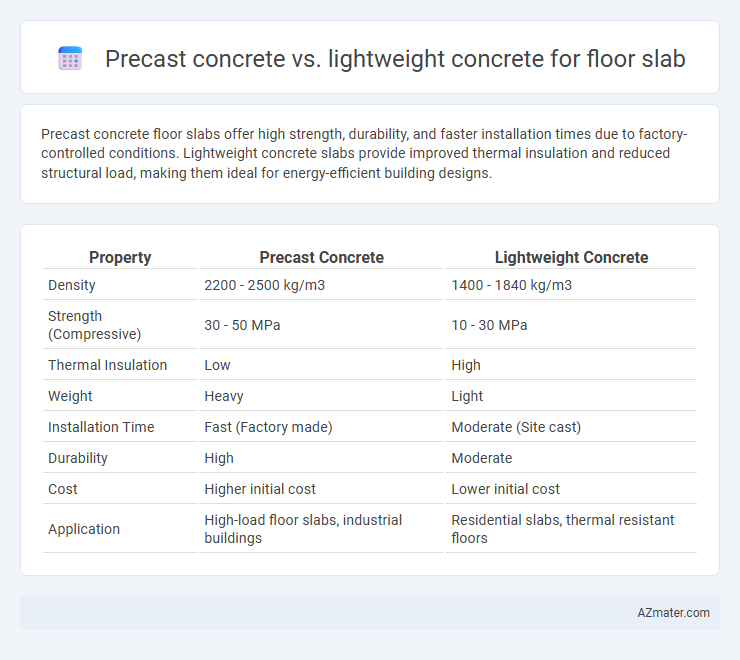Precast concrete floor slabs offer high strength, durability, and faster installation times due to factory-controlled conditions. Lightweight concrete slabs provide improved thermal insulation and reduced structural load, making them ideal for energy-efficient building designs.
Table of Comparison
| Property | Precast Concrete | Lightweight Concrete |
|---|---|---|
| Density | 2200 - 2500 kg/m3 | 1400 - 1840 kg/m3 |
| Strength (Compressive) | 30 - 50 MPa | 10 - 30 MPa |
| Thermal Insulation | Low | High |
| Weight | Heavy | Light |
| Installation Time | Fast (Factory made) | Moderate (Site cast) |
| Durability | High | Moderate |
| Cost | Higher initial cost | Lower initial cost |
| Application | High-load floor slabs, industrial buildings | Residential slabs, thermal resistant floors |
Introduction to Floor Slab Construction Methods
Precast concrete floor slabs offer high durability and rapid installation by manufacturing components off-site under controlled conditions, reducing on-site labor and construction time. Lightweight concrete floor slabs provide enhanced thermal insulation and reduced dead load, improving energy efficiency and structural design flexibility. Both methods are widely used in modern construction, with selection depending on project requirements such as load capacity, construction speed, and thermal performance.
Overview of Precast Concrete Floor Slabs
Precast concrete floor slabs offer superior quality control and faster installation compared to lightweight concrete, as they are manufactured in a controlled factory environment ensuring uniform strength and durability. These slabs provide excellent load-bearing capacity and reduced construction time, making them ideal for multi-story buildings and large-scale projects. Their high preciseness and ability to incorporate complex designs enhance structural performance while minimizing on-site labor costs.
Key Features of Lightweight Concrete Floor Slabs
Lightweight concrete floor slabs feature reduced density, typically ranging from 1,200 to 1,800 kg/m3, which lowers dead loads and enhances structural efficiency. Its superior thermal insulation properties improve energy efficiency, making it ideal for residential and commercial flooring applications. Additionally, lightweight concrete offers good fire resistance and sound insulation, contributing to safer and quieter indoor environments.
Structural Performance Comparison
Precast concrete floor slabs offer superior structural performance due to their high compressive strength, controlled manufacturing environment, and enhanced durability, resulting in better load-bearing capacity and reduced deflection under heavy loads. Lightweight concrete slabs, while providing advantages in reduced self-weight and improved thermal insulation, generally exhibit lower compressive strength and stiffness, which can limit their application in high-load structural floors. Structural engineers often select precast concrete for critical floor slab applications requiring high strength and long spans, whereas lightweight concrete is preferred for non-structural or moderate load scenarios to optimize weight and energy efficiency.
Installation Speed and Construction Efficiency
Precast concrete floor slabs offer significantly faster installation speeds due to factory-controlled production and onsite assembly, reducing overall construction timelines. Lightweight concrete slabs, while providing benefits in handling and structural load reduction, typically require longer curing times and onsite mixing, impacting installation speed negatively. Efficient project scheduling often favors precast concrete for rapid deployment, whereas lightweight concrete benefits are more aligned with specific design flexibility and thermal performance.
Cost Analysis: Precast vs Lightweight Concrete
Precast concrete floor slabs generally offer cost savings through reduced labor and faster installation times, as they are manufactured off-site under controlled conditions. Lightweight concrete slabs, while providing benefits in terms of reduced dead load and improved thermal insulation, often incur higher material costs and longer curing periods, impacting overall project timelines. Analyzing total project expenses, including transportation, handling, and structural requirements, is crucial for determining the most cost-effective solution between precast and lightweight concrete floor slabs.
Durability and Maintenance Considerations
Precast concrete floor slabs offer superior durability due to factory-controlled manufacturing processes that minimize cracks and enhance strength, ensuring long-term structural integrity with minimal maintenance. Lightweight concrete slabs provide easier handling and installation, but their lower density can lead to increased susceptibility to surface wear and potential moisture ingress, requiring more frequent inspections and repairs. Maintenance considerations favor precast concrete for its resistance to environmental factors and consistent quality, reducing lifecycle costs compared to lightweight alternatives.
Thermal and Acoustic Insulation Properties
Precast concrete floor slabs offer high thermal mass, reducing temperature fluctuations and improving energy efficiency by storing and slowly releasing heat. Lightweight concrete slabs enhance thermal insulation due to entrapped air pockets, providing better resistance to heat transfer compared to dense precast slabs. Acoustic insulation is superior in lightweight concrete as its porous structure absorbs sound waves more effectively, reducing noise transmission compared to solid precast concrete.
Sustainability and Environmental Impact
Precast concrete floor slabs offer enhanced sustainability through minimal waste generation and reduced on-site construction time, leading to lower carbon emissions. Lightweight concrete significantly decreases the structural load, improving energy efficiency in buildings and reducing material use, which contributes to lower embodied carbon. Both materials support sustainable construction; however, precast concrete's controlled manufacturing process ensures superior quality and environmental impact management compared to traditional lightweight mixes.
Choosing the Right Solution for Your Project
Choosing the right solution between precast concrete and lightweight concrete for floor slabs depends on project-specific requirements such as load-bearing capacity, installation speed, and overall budget. Precast concrete offers high strength, durability, and faster construction timelines with factory-controlled quality, while lightweight concrete reduces structural load and provides improved thermal insulation, ideal for multi-story buildings or renovation projects. Evaluating factors like structural performance, fire resistance, and cost-efficiency ensures optimal decision-making tailored to the project's design and functional needs.

Infographic: Precast concrete vs Lightweight concrete for Floor slab
 azmater.com
azmater.com